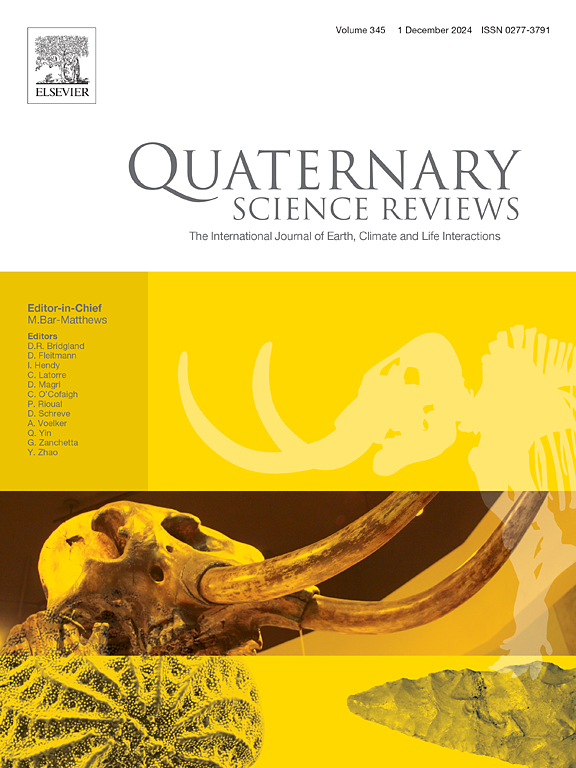波河盆地沉积物对中晚更新世冰川-静水振荡的反应
IF 3.2
1区 地球科学
Q1 GEOGRAPHY, PHYSICAL
引用次数: 0
摘要
中更新世和晚更新世的特征是高振幅的气候和海平面振荡,对全球冲积和海岸系统的演化产生了深刻影响。通过对 43 个岩心和 168 口井的数据进行关联,并借助花粉、小型动物、14C、ESR 和 IRSL 数据,该研究详细重建了波河盆地中更新世至全新世的地层,并探讨了波河-亚得里亚海冲积-海岸系统对冰川-静电振荡和其他相关影响因素的沉积反应。波河盆地的中更新世至全新世沉积演替由冲积、副冲积、沿岸和浅海岩层组成,总体呈浅水上升趋势。在这一总体趋势中,有节奏地交替出现了逐级堆积的沿岸楔块和厚厚的冲积层。在向陆地延伸的地方,沿岸地貌楔出,沉积周期性地交替记录了paralic 和冲积地貌组合。整体上的上浅趋势记录了盆地在较长时期内的逐渐充填,其动力是大量沉积物的供应,而沉积物的供应量超过了沉降所引起的容积率。地貌的周期性排列与植被的节律性变化相平行,反映了 100 ka 波段的米兰科维奇尺度的冰川-尘暴振荡。该研究为低梯度海岸系统沉积物对气候和生态环境剧烈变化的反应提供了线索。本文提出的海盆演化模型可能有助于预测近未来气候和海平面变化情况下沿海地区的环境变化。本文章由计算机程序翻译,如有差异,请以英文原文为准。
Sedimentary response of the Po Basin to Mid-Late Pleistocene glacio-eustatic oscillations
The Middle and Late Pleistocene were characterized by high-amplitude climate and sea-level oscillations that deeply influenced the evolution of alluvial and coastal systems worldwide. Through the correlation of 43 cores and 168 well data, with the aid of pollen, meiofauna, 14C, ESR and IRSL data, this work provides a detailed reconstruction of the Middle Pleistocene to Holocene stratigraphy of the Po Basin and explores the sedimentary response of the Po-Adriatic alluvial-coastal system to glacio-eustatic oscillations and other concomitant forcing factors.
The Middle Pleistocene to Holocene sedimentary succession of the Po Basin is composed of alluvial, paralic, coastal and shallow-marine facies associations arranged in an overall shallowing-upward trend. This general trend is punctuated by the rhythmical alternation of progradationally stacked coastal wedges with thick alluvial deposits. At landward locations, where the coastal facies wedge out, the depositional cyclicity records alternating paralic and alluvial facies associations. The overall shallowing-upward trend documents the longer-term, progressive filling of the basin driven by high sediment supply which overcame the rate of creation of accommodation induced by subsidence. The cyclic arrangement of facies, paralleled by rhythmical changes in vegetation, reflects Milankovitch-scale, glacio-eustatic oscillations in the 100 ka band. Increasing subsidence towards the sea and the activity of selected sectors of the buried Apennine thrust front, might have enhanced the seaward migration of coastal wedges.
This study provides clues on the sedimentary response of a low-gradient coastal system to dramatic climatic and eustatic changes. The model of basin evolution presented here may help predict the environmental modifications of coastal areas in near future scenarios of climate and sea-level change.
求助全文
通过发布文献求助,成功后即可免费获取论文全文。
去求助
来源期刊

Quaternary Science Reviews
地学-地球科学综合
CiteScore
7.50
自引率
15.00%
发文量
388
审稿时长
3 months
期刊介绍:
Quaternary Science Reviews caters for all aspects of Quaternary science, and includes, for example, geology, geomorphology, geography, archaeology, soil science, palaeobotany, palaeontology, palaeoclimatology and the full range of applicable dating methods. The dividing line between what constitutes the review paper and one which contains new original data is not easy to establish, so QSR also publishes papers with new data especially if these perform a review function. All the Quaternary sciences are changing rapidly and subject to re-evaluation as the pace of discovery quickens; thus the diverse but comprehensive role of Quaternary Science Reviews keeps readers abreast of the wider issues relating to new developments in the field.
 求助内容:
求助内容: 应助结果提醒方式:
应助结果提醒方式:


